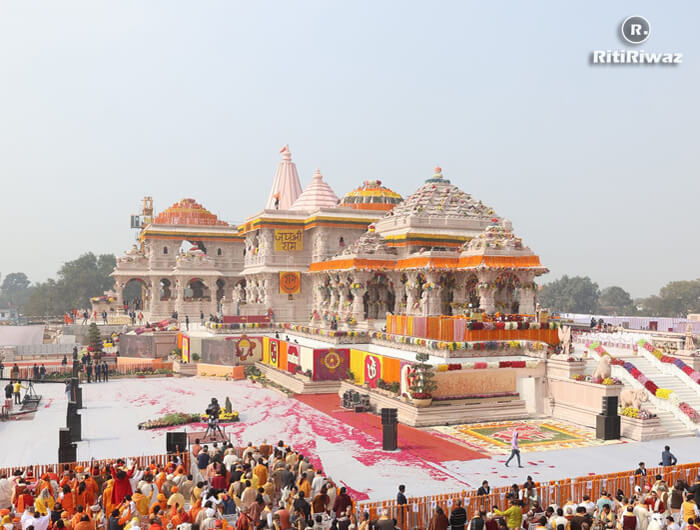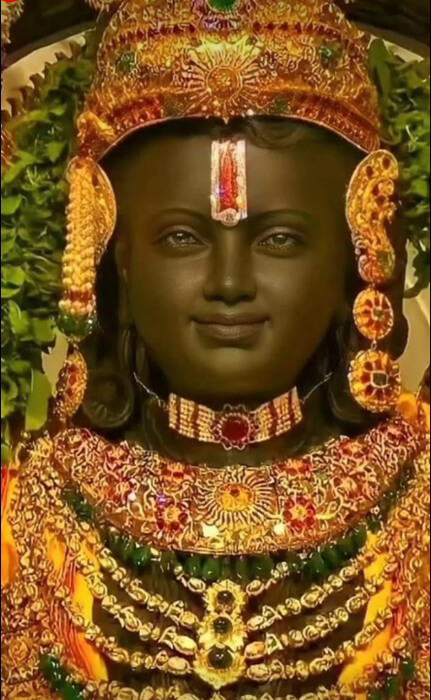Ram Mandir Ayodhya – Information, History, Facts

Ram Mandir in Ayodhya, Uttar Pradesh is a Hindu temple dedicated to Lord Ram. The temple is newly constructed and the grand Pran Pratishtha ceremony was held on January 22, 2024. The site is believed to be the birthplace of Lord Ram, an incarnation of Lord Vishnu. This place is very holy for Hindus as Rama is a highly revered deity, who is also called Maryada Purushottam or the ideal man.
The temple here was demolished by Babar the 16th century Mughal emperor who built a mosque in its place called Babri Masjid. Since then there has been a Mandir-Masjid dispute over the place. After decades of dispute, the final settlement was done by the Supreme Court of India in 2019, which ordered in favor of the construction of Ram Mandir at the said place. Ram Mandir is the first place outside of Europe to be reclaimed back from Islamic imperialism.
History
On 21st April 1526, the first battle of Panipat was held between Babur and Ibrahim Lodi. In 1528 Mir Baqi reached Ayodhya and destroyed Ram Temple to build Babri Masjid there. In 1853 it was the first time when religious unrest prevailed in Ayodhya.
The British administration divided the place in two allowing the Muslims to pray within the premises, while Hindus were allowed to pray in the outer court. Excavations carried out at the site in 1976-77 revealed the remains of an ancient and grand Hindu temple beneath the Babri mosque. Twelve pillars of the Babri mosque, which was under police custody at the time, were made from the remains of the temple, says K.K. Muhammad, one of the members of the ASI (Archeological Survey of India) team that carried out the excavation.
In 1949 Ram Lalla’s idol was found inside Babri Masjid complex. Muslims protest, and both parties file civil suits. The government proclaims the premises a disputed area and locks the gates.
Vishwa Hindu Parishad (VHP) launched a movement for a temple in 1980. Then Bharatiya Janata Party (BJP) leader Lal Krishna Advani, takes over leadership of campaign. Advani led a procession from Guijarat’s Somnath to Ayodhya. In 1986 District judge orders the gates of the disputed mosque to be opened to allow Hindus to worship there. Muslims set up the Babri Mosque Action Committee in protest. In 1989 VHP laid the foundation of a Ram Temple adjacent to the disputed mosque.
In 1992 the mosque was torn down by supporters of the VHP, the Shiv Sena party, and the BJP, prompting nationwide rioting between Hindus and Muslims in which more than 2,000 people died. For many years the controversy centred on who owned the land where the masjid had stood.
In 2003 Archaeologists began a court-ordered survey to find out whether a temple to Lord Ram existed on the site. According to the survey, there was evidence of a temple beneath the mosque. It was in 2019 when the Supreme Court of India resolved the case and the land was handed to Shri Ram Janmabhoomi Teerth Kshetra trust. It was in 2020 when the Government approved the plan for the construction of the temple, while land has also been allocated for a new mosque in Dhannipur village.
Facts
Chief Architects: Chandrakant B. Sompura, Nikhil Sompura and Ashish Sompura.
Design Advisors: IIT Guwahati, IIT Chennai, IIT Bombay, NIT Surat, Central Building Research Institute Roorkee, National Geophysical Research Institute Hyderabad, and the National Institute of Rock Mechanics KGF, Kolar.
Construction Company: Larsen and Toubro Projects (L&T)
Management Company: Tata Consulting Engineers Limited (TCEL)
Sculptors: Arun Yogiraaj (Mysore), Ganesh Bhatt and Satyanarayan Pandey
Total Area: 70 Acre (70% green Area)
Temple Area: 2.77 Acre
Temple Dimensions: Length – 380 Ft. Width – 250 Ft. Height – 161 Ft.
Architectural Style: Indian Nagara Style
Architectural Highlights: 3 storeys (floors), 392 pillars, 44 doors
How the temple will be a modern marvel?
The temple complex consists of several independent infrastructures of its own which include:
- Sewage treatment plant
- Water treatment plant
- Fire service
- Independent power station
- Pilgrims Facility Centre of 25,000 capacity to provide medical facilities and locker facilities to the pilgrims.
- Separate blocks with a bathing area, washrooms, washbasins, open taps, etc.
- 200 KVA lightning arresters to protect it from lightning.
- Museum showcasing artifacts related to Lord Ram and the Ramayana.
Thus. more than just a religious center, the Ram Mandir has been envisioned as a cultural and educational center as well.
Other Fascinating Things:
1. A time capsule has been placed approximately 2,000 feet below the ground, right underneath the temple. The capsule contains a copper plate inscribed with relevant information regarding the Ram Mandir, Lord Rama, and Ayodhya.
The purpose of this time capsule is to ensure that the identity of the temple remains intact over time so that it doesn’t get forgotten in the future.
2. The temple is an earthquake-resistant structure, with an estimated age of 2500 years.
3. The idols are made up of 60 million years old Shaligram Rocks, brought from the Gandaki River (Nepal)
4. The Bell is made of Ashtadhatu (Gold, Silver, Copper, Zinc, Lead, Tin, Iron, and Mercury)
The Bell weighs 2100 Kg. The sound of the bell can be heard up to a distance of 15 Km.

We will only be mesmerized to see how this modern temple brings prosperity in the name of dharma!
